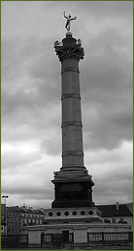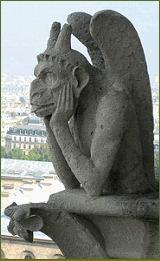|
It was designed to be 24m in height, and cast from the bronze of
cannons taken from the Spanish. You would have been able to access the top was going
to be achieved by a stairway set in one of the legs of the monument, however, only a scale
plaster model was ever built.
Victor Hugo immortalised the monument in the novel Les Miserables, but it was demolished
in 1846.
In 1833, Louis-Philippe decided to build the July Column as originally planned in 1792 and
it was inaugurated in 1840.
Early history of the Bastille
The Bastille was built between 1370 and 1383 as part of the defences of Paris, and Charles VI of France reputedly converted the
structure into a prison in the 17th century. At that time it primarily housed
political prisoners, but also religious prisoners and young rakes held at the request of
their families. When it became the main prison for those taken under 'lettres de
cachet' that were issued by the King of France, it began to acquire a very poor
reputation.
By the late 18th century, the Bastille
building was made up of eight towers, which were around 24m high, and surrounded 2
courtyards and the armoury.
The prisoners were held at 5-7 storeys in the towers, each person having a room around
4.6m across and containing various articles of furniture.
The infamous cachots (dungeons), which were oozing, vermin-infested subterranean cells,
were no longer in use, due to the disgusting nature of these lower cells.
The governor of the prison was given a daily allowance per prisoner, the amount depending
on their status ranging from scientists and academics at the top, going down to the
commoners at the bottom level and in terms of standard, even for the commoners, there were
many worse prisons in France, including the dreaded Bicetre, which was also in Paris.
Storming of the Bastille
The confrontation from the commoners ultimately led to the people of Paris storming the
Bastille on 14 July 1789, after several days of disturbances. At this point, the
jail was nearly empty, with only seven inmates. There were 4 counterfeiters, 2
madmen, and a young aristocrat who had displeased his father.
A crowd of around 1,000 people gathered outside the Bastille, calling for the surrender of
the prison, the removal of the guns and the release of the arms and gunpowder. Two people
chosen to represent those gathered were invited into the fortress and slow negotiations
began.
In the early afternoon, the crowd broke into the undefended outer courtyard and the chains
on the drawbridge to the inner courtyard were cut. An exchange of gunfire began and
in the mid-afternoon mutinous Gardes Francaises of the Royal Army and 2 cannons reinforced
the crowd. De Launay ordered a ceasefire and despite his surrender demands being
refused, he capitulated and the victors swept in to liberate the fortress at around
5:30pm.
98 attackers and 1 defender died. De Launay was seized and dragged towards the
H?tel de Ville, but was stabbed to death by the mob in the street and several of De
Launay's officers were also killed. The Gardes Fran?aises intervened to protect the Swiss
soldiers and the invalids of the garrison and the officer commanding the Swiss detachment
later prepared a detailed account of the fall of the fortress which, laid blame on De
Launay for his indecisive behaviour.
When the rioters had freed the 7 prisoners, they then beheaded the governor and the guards
of the Bastille.
Many historians believe that the storming of the Bastille was more important as a rallying
point and symbolic act of rebellion than any practical act of defiance, and it was not the
image typically conjured up of courageous French patriots storming a towering fortress and
freeing hundreds of oppressed peasants.
Demolition of the Bastille
The fate of the Bastille was uncertain, but Pierre-Francois Palloy was quick to establish
a claim, organising a force of demolition men around the site. Over the next few days many
notables visited the Bastille and it seemed to be turning into a memorial, but
Pierre-Francois Palloy secured a license for demolition and quickly took complete control.
He put much effort into the site as a paying attraction and producing a huge range of
souvenirs, including much of the rubble and by November 1789 the structure was largely
demolished.
|
|



